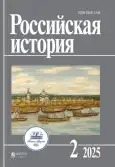Social connections and the construction of imperial space under Peter the Great (the circle of communication of architect J.-B. A. Leblon)
- Autores: Ermakova O.K.1, Nakishova M.T.1
-
Afiliações:
- The Institute of History and Archaeology, Ural Branch of the Russian Academy of Sciences
- Edição: Nº 2 (2025)
- Páginas: 104-115
- Seção: Institutions and communities
- URL: https://modernonco.orscience.ru/2949-124X/article/view/685799
- DOI: https://doi.org/10.31857/S2949124X25020191
- EDN: https://elibrary.ru/DRQMYA
- ID: 685799
Citar
Texto integral
Resumo
The article is devoted to identifying methods and approaches that allow studying the mechanisms of constructing imperial space in Russia in the first quarter of the 18th century through the reconstruction of social ties of the persons who created the architectural symbols of power. In this context, it is assumed that the focus of research attention should be shifted from the figure of the monarch as the main actor setting the direction of activity on the construction of architectural objects to the system of social connections of people of various ranks who implemented the plans of the sovereign in practice. The authors conclude that the method of social network analysis (and historical social network analysis) can be the most productive for studying such problematics. The paper shows general characteristic of the system of social ties that developed between the participants in the construction of the royal residences and the new capital – St. Petersburg.
Texto integral
Sobre autores
Olga Ermakova
The Institute of History and Archaeology, Ural Branch of the Russian Academy of Sciences
Autor responsável pela correspondência
Email: otech_ist@mail.ru
Senior Researcher
Rússia, YekaterinburgMarina Nakishova
The Institute of History and Archaeology, Ural Branch of the Russian Academy of Sciences
Email: otech_ist@mail.ru
Researcher
Rússia, YekaterinburgBibliografia
- Beik W.H. Governing Languedoc: The Practical Functioning of Absolutism in French Province, 1633–1685. Ph.D. Diss. Harvard University, 1995.
- Beik W.H. Magistrates and popular uprisings in France before the Fronde: The Case of Toulouse // Journal of Modern History. 46 (December 1974). P. 585–608.
- Beik W.H. The Absolutism of Louis XIV as Social Collaboration // Past & Present. Volume 188. Issue 1, 1 August 2005. P. 195–224.
- Blanning T.C.W. The Culture of Power and the Power of Culture. Oxford, 2002.
- Burke P. The Fabrication of Louis XIV. New Haven, 1992.
- Johannsen B.B. The King and His Temple // Bulletin du Centre de recherche du château de Versailles [En ligne], Le promeneur de Versailles, mis en ligne le 03 avril 2018, consulté le 06 juillet 2024 (URL: http://journals.openedition.org/crcv/14740).
- Jouanna A. Des reseaux d’amitié aux clientèles centralisés: les provinces et la cour (France, XVIe – XVIIe siècle) // Patronages et clientélismes, 1550–1750: France, Angleterre, Espagne, Italie: actes du colloque, Institut français du Royaume-Uni, Londres, 3–5 mai 1990. Londres, 1995P. 21–38.
- Kettering S. Patronage in Sixteenth- and Seventeenth-Century France. Ashgate, 2002.
- Kettering S. Patrons, Brokers and Clients in Seventeenth-Century France. N.Y.; Oxford, 1986.
- Mettam R. Power and Faction in Louis XIV”s France. Oxford, 1988.
- Mousnier R. Les concepts d’«ordres», d’«états», de «fidélité» et de «monarchie absolue» en France de la fin du XVe siècle à la fin du XVIIIe // Revue historique. 1972. № 502. P. 289–312.
- Mousnier R. Les fidélités et les clientèles en France aux XVIe, XVIIe et XVIIIe siècles // Histoire sociale. Vol. 15. 1982. № 29. P. 35–46.
- Nijenhuis A. La Guerre de Hollande (1672–1678) et la glorification de Louis XIV à Versailles // Biblio 17, 167 (2006). P. 293–321.
- Patronages et clientélismes, 1550–1750: France, Angleterre, Espagne, Italie: actes du colloque, Institut français du Royaume-Uni, Londres, 3–5 mai 1990. Londres, 1995.
- Sabatier G. Versailles ou La disgrâce d’Apollon. Rennes; Versailles, 2016.
- Sabatier G. Versailles ou la figure du roi. P., 1999.
- Wetherell C. Historical Social Network Analysis // International Review of Social History. 1998. № 43. P. 125–144.
Arquivos suplementares










